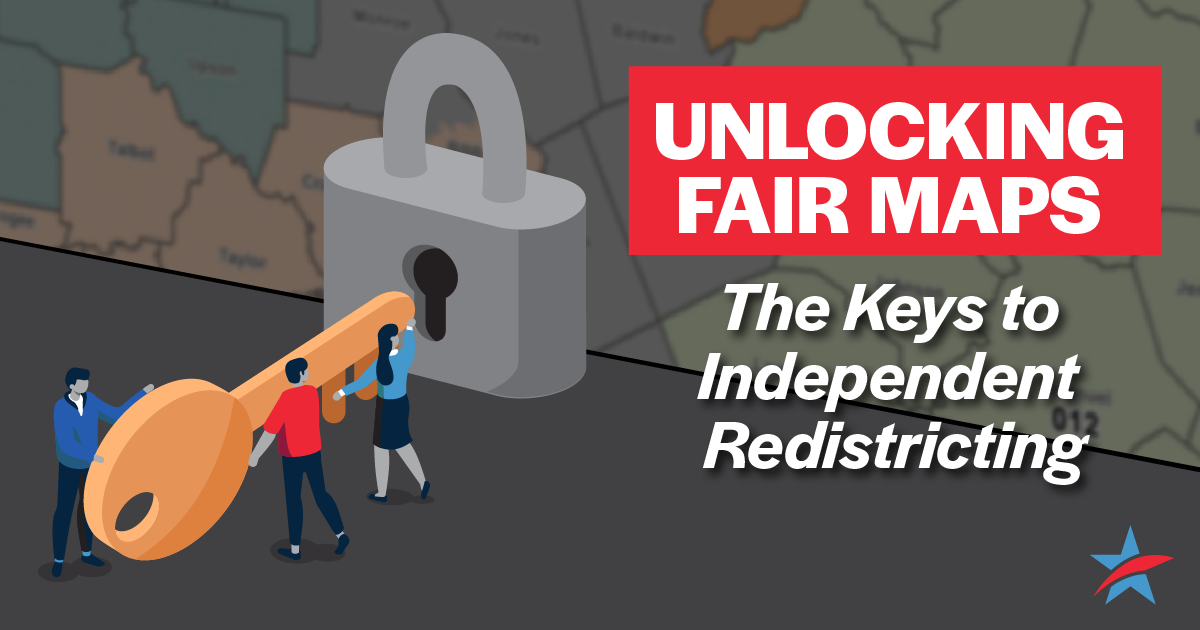Báo cáo
Báo cáo
Mở khóa Bản đồ Công bằng: Chìa khóa để Phân chia lại Khu vực Bầu cử Độc lập

Việc phân chia lại khu vực bầu cử, tức việc vẽ lại ranh giới các khu vực bỏ phiếu, là một phần không thể thiếu của nền dân chủ hiệu quả tại Hoa Kỳ. Cứ 10 năm một lần sau cuộc điều tra dân số liên bang, Hiến pháp Hoa Kỳ yêu cầu các tiểu bang và các khu vực pháp lý nhỏ hơn phải vẽ lại bản đồ bầu cử bằng cách tạo ra các khu vực bầu cử có số lượng cư dân bằng nhau. Điều này tính đến bất kỳ sự thay đổi dân số nào trong thập kỷ trước và đảm bảo rằng các cộng đồng có cùng quy mô sẽ có cùng số lượng đại diện trong chính phủ.
Quá trình này đóng vai trò cơ bản trong việc xác định cán cân quyền lực ở Washington, D.C., các thủ phủ tiểu bang và mọi cấp chính quyền khác. Chính vì tầm quan trọng của nó, việc phân chia lại khu vực bầu cử đã bị thao túng bởi các thủ đoạn và chính trị hóa kể từ khi thành lập nước cộng hòa.
Một giải pháp cho cuộc chiến kéo dài hàng thập kỷ này vì sự công bằng trong phân chia khu vực bầu cử đã tồn tại: các ủy ban phân chia khu vực bầu cử độc lập (IRC). Các thực thể đa đảng và đa thành viên này có thẩm quyền cuối cùng trong việc phân chia khu vực bầu cử mỗi thập kỷ thay vì để các chính trị gia phê duyệt bản đồ. Các nhà vận động và tổ chức đã và đang vận động cho giải pháp này tại các tòa thị chính và cơ quan lập pháp tiểu bang, cũng như thông qua các sáng kiến bỏ phiếu. Chúng tôi biết giải pháp này hiệu quả vì nhiều tiểu bang và thành phố trong vài thập kỷ qua đã thành công trong việc triển khai bản đồ bầu cử mới bằng cách sử dụng một ủy ban phân chia khu vực bầu cử độc lập.
Báo cáo này đi sâu vào những cân nhắc mà các nhà vận động và hoạch định chính sách phải đối mặt khi đề xuất một ủy ban phân chia lại khu vực bầu cử độc lập. Báo cáo mô tả và đánh giá các yếu tố chung của các ủy ban hiện đại. Mỗi phần của báo cáo này cung cấp ngôn ngữ luật định mẫu từ các khu vực pháp lý hiện hành, mặc dù không phải mọi ví dụ đều đến từ một IRC. Mỗi IRC nên được thiết lập để phục vụ tốt nhất nhu cầu của tiểu bang hoặc địa phương của bạn vì không có mô hình nào phù hợp cho tất cả các ủy ban độc lập. Nếu có thể, chúng tôi cung cấp các khuyến nghị hoặc hướng dẫn về các phương pháp hay nhất và những điều cần tránh.
“Phân chia lại khu vực bầu cử là việc trao lại quyền lực cho cử tri. ... Khi các chính trị gia— Luis Gonzalez, Ủy viên, Ủy ban Phân chia lại Khu vực Bầu cử của Công dân Độc lập Thành phố Austin
đang cố gắng thu hút các quận theo hướng có lợi cho họ, [thay vì] những gì có lợi nhất
của cư dân hoặc cộng đồng của họ, đó là một vấn đề có gốc rễ từ chính trị. Chúng tôi
đã chứng kiến sự thành công [của] việc phân chia lại khu vực bầu cử ở cấp thành phố và tiểu bang khi các tiểu bang, thành phố
có các ủy ban phân chia lại khu vực bầu cử, họ có thể tập trung vào các vấn đề khác ngoài chính trị hoặc
giao ước hoặc kết quả bầu cử.”
Tài nguyên liên quan
Báo cáo

